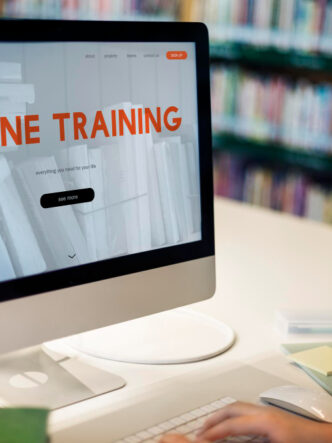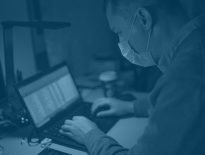With coronavirus now recognised as an official pandemic by the World Health Organization, is it time we start rolling out higher education programs that can be operated remotely?
While politicians and governments in countries around the world try to suppress mass-panic, we wanted to know if stay-home-studying, and working from home, might be the answer to stop the spread. We took a more in-depth look to try and find out.
The Spread of COVID-19
Covid-19 has formally been declared a pandemic by the World Health Organization. So far, more than 107 countries have been subjected to this highly infectious virus. Coronavirus has seen widespread panic as it races through countries around the world. As it stands, the combination of being highly contagious and having a mortality rate of around 3.4% – substantially higher than the flu.
Symptoms of this terrifying disease include shortness of breath, a dry cough and a fever. Public health advice is that those who catch coronavirus stay home from work and school. Staying home prevents the spread of the disease, allowing the symptoms to pass so you do not spread it further. Unfortunately, it is too late for places like Washington State, who are already experiencing deaths from the virus.
Higher Education Needs to Change
Asides from the mounting pressure to stay home, coronavirus has brought other things to light. Namely, certain places are breeding grounds for bacteria. Places like canteens, halls of residence, and even the lecture hall. In fact, Universities bring together large groups of students from different cross-sections of society. Worse, the lecture hall brings students together for far longer than the 10 minute infection period.
In the case of Washington State, for example, officials believe that Coronavirus has been breeding there for weeks. Undetected, Covid-19 has spread to an estimated 1,500[1] people unwittingly. How many of that number were students? How many infected others by coughing in the lecture hall or refectory? With the World Health Organisation advising us that getting ‘workplace-ready’ involves the careful management of meetings as part of risk assessment.
This battle of interests seems adverse at a time when the world is resisting mass panic spread via news and social media. Might we suggest that there is a fairly simple way around it for all involved? It involves the internet, the clever use of video software, and students participating in the advice to stay home until the worst of it blows over…

The Case Study
To exemplify how remote learning can easily work, we refer to our earlier collaborative works with edWeb, here at Cincopa. edWeb is a free professional learning community that mixes peer support and more traditional teaching methods to help educators make the most of online classes.
edWeb came to us with very specific needs. They wanted to be able to track how often their educational videos were used, from what devices, and in real-time. They needed an API for expedient data synchronisation, that would be able to attach question and answer sessions to their videos, to create a functional digital learning environment.
edWeb attracts some 65,000 monthly views, comprises an archive 2,000+ webinars strong, and educates from a kindergarten to a librarian grade level. With so many users, so much activity and thousands of views per month; they needed a firm capable of creating online videos that worked for them, not against them.
Our aims for phasing into the edWeb scene were to create seamless, timeless content that was always available for viewing – no matter the time, place, or device used. One of their main concerns was that they had no way to track who was viewing what, where, or when. Our analytical programs were able to give them this feedback at-a-glance, and in real-time, allowing them to monitor what videos worked and what didn’t, as well as allowing them to develop their next set of videos, based on that feedback.
The second main issue edWeb had was that they needed to send users off-platform to view their videos. This lost them opportunities, sent clients off the site, and wasn’t very user-friendly. Using a tailored version of our higher education programs (complete with a separate landing page), we were able to keep their views in a more manageable place. This also enabled our API to communicate with edWeb’s CRM, giving that valuable data feedback as we worked.

How Higher Education can Work Remotely
Using the same methods, we can apply the Cincopa higher education model to Universities whose students need to stay home for the 14 day self-isolation period that coronavirus is imposing on us. This way, students can still learn from the comfort of their own homes. Tutors can even record lessons from their location, eliminating the need for a bricks and mortar establishment entirely.
Using Cincopa, teachers and students staying home for 14 days or more won’t even miss out on their lessons. They even offer a 30 day free-trial. Lectures can be recorded via RecTrace to provide working-at-home solutions to students. Those studying can learn, free of possible contamination or outside bacteria.
Furthermore, once a video or lecture is recorded and placed online; it can be used time and time again to teach the same lesson. It still needs to be updated as new information is discovered – but it can stand as an earlier version of itself. You can use Cincopa Online Video Course to put coursework online permanently, giving only students of the university access to protect said data. Version saving then allows you to track the progress of acquired knowledge in a hands-off way.
The proverbial cherry-on-top of this method is that Cincopa Analytics can trace every detail of your content. This would mean that, as a University, you would be able to see how many of your students were actually interacting with the coursework. You would theoretically be able to track which devices are used and at what times of day, to gain better understanding of how, why, when and what should be taught.
By the addition of a good landing page and the introduction of Cincopa into your higher education course, you could combat Covid-19 in your own way. Help keep infection and contamination to a minimum by teaching remotely. Cincopa can help establish, monitor, and maintain your video network… all you need to do is make the commitment to get online.










